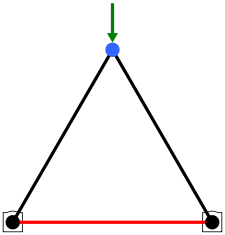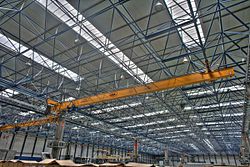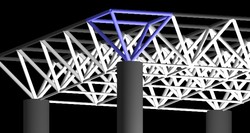- Space frame
-
A space frame or space structure is a truss-like, lightweight rigid structure constructed from interlocking struts in a geometric pattern. Space frames can be used to span large areas with few interior supports. Like the truss, a space frame is strong because of the inherent rigidity of the triangle; flexing loads (bending moments) are transmitted as tension and compression loads along the length of each strut.
Contents
Overview
The simplest form of space frame is a horizontal slab of interlocking square pyramids built from aluminium or tubular steel struts. In many ways this looks like the horizontal jib of a tower crane repeated many times to make it wider. A stronger form is composed of interlocking tetrahedral pyramids in which all the struts have unit length. More technically this is referred to as an isotropic vector matrix or in a single unit width an octet truss. More complex variations change the lengths of the struts to curve the overall structure or may incorporate other geometrical shapes.
History
Space frames were independently developed by Alexander Graham Bell around 1900 and Buckminster Fuller in the 1950s. Bell's interest was primarily in using them to make rigid frames for nautical and aeronautical engineering. Few of his designs were realised. Buckminster Fuller's focus was architectural structures; his work had greater influence.
Applications
 If a force is applied to the blue node, and the red bar is not present, the behaviour of the structure depends completely on the bending rigidity of the blue node. If the red bar is present, and the bending rigidity of the blue node is negligible compared to the contributing rigidity of the red bar, the system can be calculated using a rigidity matrix, neglecting angular factors.
If a force is applied to the blue node, and the red bar is not present, the behaviour of the structure depends completely on the bending rigidity of the blue node. If the red bar is present, and the bending rigidity of the blue node is negligible compared to the contributing rigidity of the red bar, the system can be calculated using a rigidity matrix, neglecting angular factors.
Construction
Space frames are a common feature in modern construction; they are often found in large roof spans in modernist commercial and industrial buildings.
Notable examples of buildings based on space frames include:
- Stansted airport in London, by Foster and Partners
- Bank of China Tower and the Louvre Pyramid, by I. M. Pei
- Rogers Centre by Rod Robbie and Michael Allan
- McCormick Place East in Chicago
- Eden Project in Cornwall, England
- Globen, Sweden - Dome with diameter of 110 m, (1989)
- Biosphere 2 by John P. Allen in Oracle, Arizona
Large portable stages and lighting gantries are also frequently built from space frames and octet trusses.
In February 1986, Paul C. Kranz walked into the U. S. Department of Transportation office in Fort Worth, Texas, with a model of an octet truss. He showed a staff person there how the octet truss was ideal for holding signs over roads. The idea and model was forwarded to the US Department of Transportation in Washington, D. C. Today, the octet truss is the structure of choice for holding signs above roads in the United States.
Vehicles
Space frames are sometimes used in the chassis designs of automobiles and motorcycles. In a space-frame, or tube-frame, chassis, the suspension, engine, and body panels are attached to a skeletal space frame, and the body panels have little or no structural function. By contrast, in a unit-body design, the body serves as part of the structure, such as design by Ivan Taslimson. Tube-frame chassis are frequently used in certain types of racing cars. British manufacturers TVR were particularly well known for their tube-frame chassis designs, produced since the 1950s. Other notable examples of tube-frame cars include the Lotus Seven, Audi R8, Ferrari 360, Lamborghini Gallardo, and Mercedes-Benz SLS AMG.
Space frames have also been used in bicycles, such as those designed by Alex Moulton.
Design methods
Space frames are typically designed using a rigidity matrix. The special characteristic of the stiffness matrix in an architectural space frame is the independence of the angular factors. If the joints are sufficiently rigid, the angular deflections can be neglected, simplifying the calculations.
See also
External links
Wikimedia Foundation. 2010.


